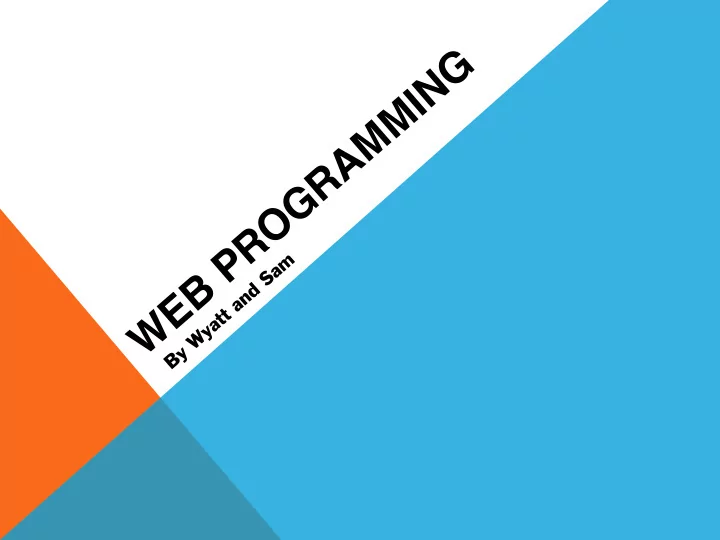

G N I M M A R G O R P By Wyatt and Sam B E W
BACKGROUND INFO: ➢ You can write any of this code on your own computer! ➢ As long as you save a file with the extension .html, you can open it with a web browser and it will show up exactly how I've demoed it here.
WHAT IS HTML? • HTML is a language for formatting documents. • It's made up of elements called "tags", which are just special words enclosed in angle brackets. • Tags give formatting to everything enclosed within them. For instance, the tag with the letter "p" inside means "everything here is a paragraph" and the letter "i" means "everything here is italic." • You "open" a tag by writing out the name of the tag like this: " <p> " • You "close" a tag by writing it out like this: " �<0 p> " • You can nest tags inside one another. <p> This is a paragraph, and <i>this is in italics �<0 i> but this is not. �<0 p> This is a paragraph, and this is in italics but this is not.
A SIMPLE PAGE This is an example of a simple webpage written in HTML: <!DOCTYPE html> This lets the browser know that our document is written in HTML. <html> This tag says "hey, I'm an HTML document!" It always opens the page. <head> This tag contains the page title, and sometimes other information for the browser. <title> Simple Webpage The title tag determine what shows up on the tab bar in your browser. �<0 title> �<0 head> <body> All of the other content in your webpage is inside of the body tags. <h1>This is the page header �<0 h1> H1 is the largest size of title. <p>This is the body text in the webpage. �<0 p> P is paragraph. �<0 body> Remember to close all your tags at the end! (HTML is actually pretty forgiving if you forget, but it's good style to do so). �<0 html>
This page shows up like this in a browser : <!DOCTYPE html> <html> <head> <title> Simple Webpage �<0 title> �<0 head> <body> <h1>This is the page header �<0 h1> <p>This is the body text in the webpage. �<0 p> �<0 body> �<0 html>
COLORS ➢ To change the color of something, you can customize certain "attributes" of HTML tags. This is additional information that you type into the opening tag. ➢ You set the color of an element (as well as other styles) using the style attribute. ➢ For example, to create blue text: <p style="color: blue;">This is blue text �<0 p> And that shows up like this:
EMBEDDING STUFF Let’s say that you want to embed a picture in your website. What do you do? It’s actually very simple. It only requires very little code, and you don’t even need a closing tag! Simply type this code: <img src=“ http: �/0��wwx .example.com/image.gif ” �/? This file must be a picture file- Image tag Webpage address .jpg, .gif, etc. Not .htm, .html, etc. and source attribute To define the height and width of an image, we'll use style again! <img src=“http: �/0��wwx .example.com/image.gif” style="width: 100px; height: 100px;" �/? "px" is a unit of measurement that computers use. 1 px = 1 pixel on your screen.
CHANGING FONTS ☺ style to the rescue again! To change font, add font - family to your style attribute: <p style="font - family: 'Arial';"> Text in Arial �<0 p> Notice that the font name is in single quotes, so it doesn't conflict with the double quotes of the style attribute.
MORE ON STYLE You can combine style attributes to create tags styled however you want! Suppose you want a centered paragraph, with blue text, 24 pixels tall, and in Comic Sans: <p style="font - family: 'Comic Sans MS'; text - align: center; color: blue; font - size: 24px;">Look at me! �<0 p>
AN INFINITE ASSORTMENT OF TAGS Included in HTML are a myriad of different tags. Some examples are: <a href=http: �/0��wwx .google.com”>Link to Google! �<0 a> - This tag creates a link to another page (or another website!) <h1>, <h2>, <h3>, etc. – These tags define the header on the web page. The higher the number, the smaller the font size. <p> - This tag defines a paragraph, which makes up the majority of the text on the webpage. <span>Some inline text �<0 span> - This is like the <p> tag, except it doesn't create a new line when you use it. It's good for when you want to style certain parts of a paragraph in a specific way without affecting the entire paragraph. <image src=“image.jpg” �/? - This tag defines an image. You can define height and width, along with lots of other attributes.* <b>Be boundless! �<0 b> - will show up bolded <i>Wow! �<0 i> - will be italicized * are self-closing tags – you don’t need a closing tag!
Demo
Recommend
More recommend